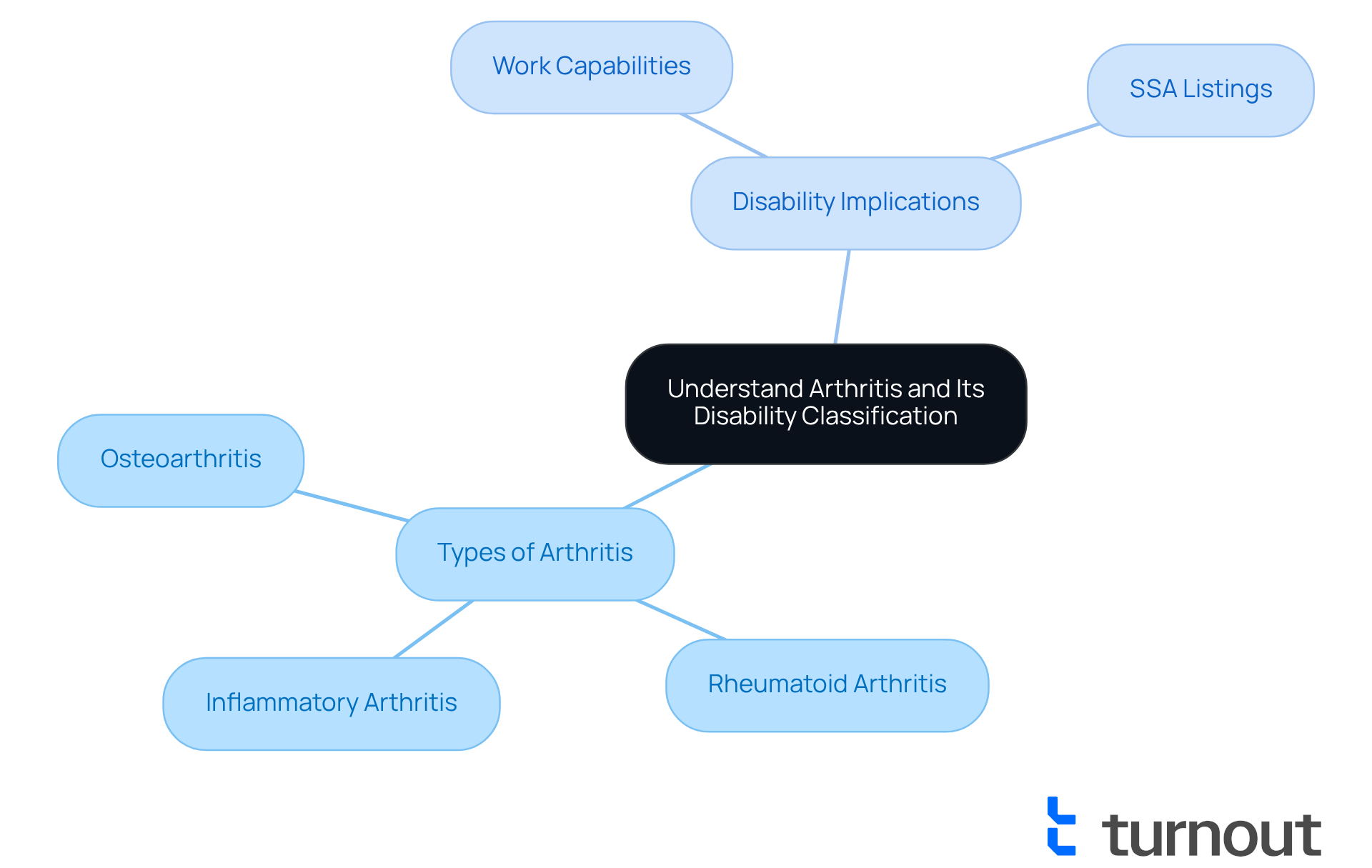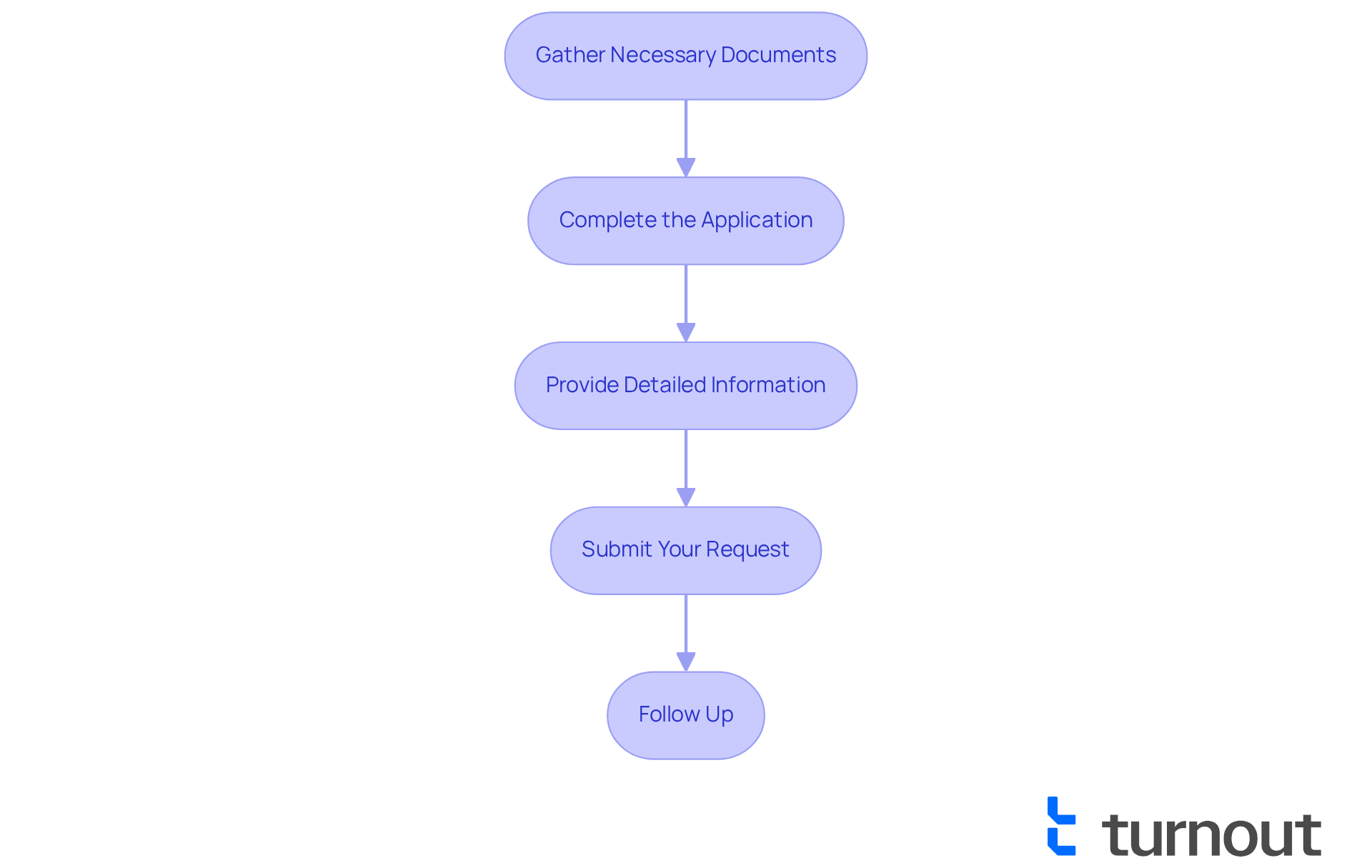Overview
If you are living with arthritis, you may be eligible for disability benefits. It's important to understand that these benefits are available to those who can show how the condition significantly affects their ability to work and carry out daily activities. We recognize that navigating this process can feel overwhelming, but you are not alone in this journey.
To help you, this article outlines essential steps for a successful application:
- Medical documentation is crucial. This includes records from your healthcare provider that detail your diagnosis and treatment.
- Understanding your functional limitations is vital. How does arthritis impact your daily life? Reflecting on this can strengthen your case.
- Familiarity with the Social Security Administration (SSA) criteria is key. These guidelines will help you establish your eligibility based on the severity of your arthritis.
Remember, we’re here to help you through this process, ensuring you have the support you need every step of the way.
Introduction
Understanding the complexities of arthritis and its impact on daily life is essential for those seeking disability benefits. We recognize that with over 100 types of joint diseases, including the prevalent osteoarthritis and rheumatoid arthritis, many individuals face significant challenges in their daily activities and work capabilities.
This article explores the critical steps to successfully apply for disability benefits, shedding light on eligibility criteria and the application process. It's common to feel overwhelmed by the journey ahead—can one truly navigate the intricacies of the Social Security Administration's requirements and emerge victorious in their quest for assistance?
Rest assured, you are not alone in this journey. We're here to help guide you through it.
Understand Arthritis and Its Disability Classification
Joint diseases encompass over 100 distinct forms, with osteoarthritis and rheumatoid conditions being the most common. We understand that dealing with joint inflammation can be challenging. The SSA categorizes these conditions under musculoskeletal disorders, raising the question of whether you can get disability for arthritis if they significantly limit your ability to work. To qualify, you need to show that your and work capabilities; this raises the question, can you get disability for arthritis?
Comprehending the specific type of joint inflammation you have, along with its symptoms and severity, is crucial for assessing your eligibility for benefits. For example, inflammatory arthritis, which includes rheumatoid arthritis, is evaluated differently than degenerative arthritis like osteoarthritis. Familiarizing yourself with the SSA's listings for musculoskeletal disorders can help you understand where your condition fits in.
At Turnout, we're here to help you . We offer tools and services designed to ensure you comprehend how your specific condition may impact your eligibility for benefits. Our trained nonlawyer advocates are dedicated to assisting you on this journey, making the process more accessible without the need for legal representation. Remember, you are not alone in this journey; we are here to support you every step of the way.

Determine Eligibility Criteria for Disability Benefits
Navigating the path to qualifying for disability benefits raises the question, due to joint inflammation, which can be challenging. We understand that this journey may feel overwhelming, but knowing the specific criteria established by the SSA can help you find clarity and support.
To begin, you'll need . This means obtaining a formal diagnosis from your healthcare provider, along with detailed medical records that outline the severity of your condition. Important elements include test results, treatment history, and any prescribed medications.
Next, it's essential to demonstrate your . This involves showing how joint inflammation affects your ability to perform fundamental work activities. Consider how it may restrict your capacity to stand, walk, lift, or even carry out fine motor tasks.
Additionally, your condition must be expected to last at least 12 months. Temporary conditions do not qualify, so understanding the duration of your arthritis is crucial.
If you're applying for Insurance (SSDI), your is another critical factor. You need to have sufficient work credits based on your employment history. For Supplemental Security Income (SSI), different financial eligibility requirements apply.
by offering tools and services that assist you in navigating SSD claims. It's important to remember that while Turnout is not a law firm and does not provide legal advice, they can help answer questions such as can you get disability for arthritis. With trained nonlawyer advocates and IRS-licensed enrolled agents, Turnout can guide you expertly without the need for legal representation.
Collecting thorough medical records and understanding how your condition impacts your daily life are essential steps in this endeavor. Remember, you are not alone in this journey; we’re here to help you every step of the way.

Follow the Application Process for Disability Benefits
Navigating the application process for can feel overwhelming, but you are not alone in this journey. By following these steps, you can simplify the experience:
- Gather Necessary Documents: Start by collecting all relevant medical records, including your diagnosis and treatment history. Consistent documentation of your condition is crucial, as it strengthens your case.
- Complete the Application: You can apply online through the SSA website, by phone, or in person at your local SSA office. Make sure to fill out all sections accurately and completely to avoid delays.
- When providing detailed information, be specific about how arthritis affects your daily life and work capabilities, especially in relation to whether you can get disability for arthritis. Include details about pain levels, mobility issues, and any assistive devices you use. This level of detail can significantly impact the evaluation of your claim.
- Submit Your Request: After reviewing your submission for completeness, send it through your chosen method. Keep copies of everything for your records.
- Follow Up: After submission, keep track of the status of your request. You may need to provide additional information or attend a consultative examination if requested by the SSA. Being proactive can help address any issues that arise promptly.
Turnout offers access to who can assist you during this process, ensuring that your submission is as robust as possible. It’s important to note that Turnout is not a law firm and does not provide legal advice. Data indicate that around 62% of initial SSDI requests are rejected across the country. However, understanding the system and preparing thoroughly can . Advocates emphasize that and organizing all required paperwork can lead to more positive outcomes for individuals who are asking, . As one supporter mentioned, ' of how your condition impacts your daily life can make a significant difference in the approval procedure.

Address Challenges in the Application Process
Navigating the procedure for can indeed present several challenges. We understand that this journey can feel overwhelming at times. Here are some common issues you might face and how to address them:
- Incomplete Submissions: It's crucial to ensure that all sections of your form are filled out completely. Missing information can lead to delays or denials. Double-check your form before submission to avoid these common pitfalls.
- : The (SSA) requires substantial medical documentation to support your claim. If your initial submission is denied due to insufficient evidence, don't lose hope. Collect more documentation and consider reapplying or seeking a review. Many applicants face similar challenges, but persistence can lead to success.
- Understanding SSA criteria is essential to determine if you can get . If your condition does not meet the specific listings, you may still qualify based on your functional limitations. Be prepared to explain how your arthritis impacts your daily life, as this can significantly influence if you can get disability for arthritis.
- Denials and Appeals: If your request is denied, don’t be discouraged. It's common to feel disheartened, but statistics indicate that by the SSA. However, a substantial portion of applicants . by requesting a hearing. Gather more evidence and consider seeking assistance from Turnout's trained , who specialize in disability claims, to strengthen your case. Remember, Turnout provides various tools and services to help you navigate these complex processes without the need for legal representation.
By anticipating these challenges and preparing accordingly, you can enhance your chances of a successful application. You're not alone in this journey, and we're here to help.

Conclusion
Understanding the pathway to obtaining disability benefits for arthritis can significantly impact individuals grappling with the challenges of joint inflammation. We recognize how overwhelming this process can feel, and this article outlines essential steps and considerations to help clarify whether you can qualify for these benefits. It’s important to recognize the specific type of arthritis and its effects on daily functioning.
Key points discussed include:
- The necessity of thorough medical documentation
- Demonstrating functional limitations
- Understanding the specific eligibility criteria set forth by the Social Security Administration (SSA)
We understand that navigating this information can be daunting, but having a detailed overview of the application process can empower you. Common challenges applicants face—such as incomplete submissions and insufficient medical evidence—are addressed. By proactively tackling these issues and utilizing available resources, you can bolster your chances of a successful claim.
In conclusion, navigating the complexities of disability claims for arthritis is a journey that requires patience, preparation, and support. It’s crucial to gather comprehensive documentation and articulate how your condition affects daily life. Remember, it’s common to feel frustrated in the face of potential setbacks, but persistence is key. By following the outlined steps and seeking assistance when needed, you can take meaningful strides toward securing the benefits you deserve. You are not alone in this journey; understanding and preparation are vital to overcoming the obstacles in the application process.
Frequently Asked Questions
What are the most common types of arthritis?
The most common types of arthritis are osteoarthritis and rheumatoid arthritis.
How does the SSA classify arthritis?
The SSA classifies arthritis under musculoskeletal disorders.
Can you get disability for arthritis?
Yes, you can qualify for disability for arthritis if you can show that your joint condition significantly limits your ability to work and affects your daily activities.
Why is it important to understand the specific type of arthritis one has?
Understanding the specific type of arthritis, along with its symptoms and severity, is crucial for assessing eligibility for benefits, as different types are evaluated differently.
How does the SSA evaluate inflammatory arthritis compared to degenerative arthritis?
Inflammatory arthritis, such as rheumatoid arthritis, is evaluated differently than degenerative arthritis like osteoarthritis by the SSA.
What resources are available to help with SSD claims for arthritis?
Turnout offers tools and services to help individuals understand how their specific condition may impact their eligibility for benefits, along with support from trained nonlawyer advocates.
Do I need legal representation to navigate the SSD claims process for arthritis?
No, you do not need legal representation; Turnout provides assistance to make the process more accessible without the need for a lawyer.




